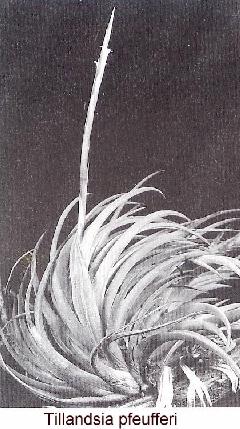
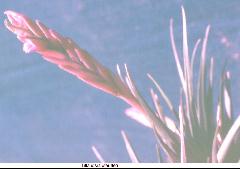
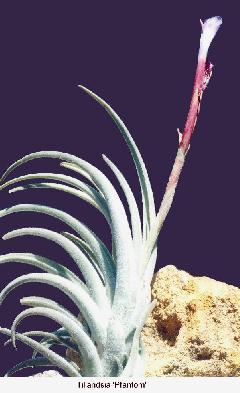
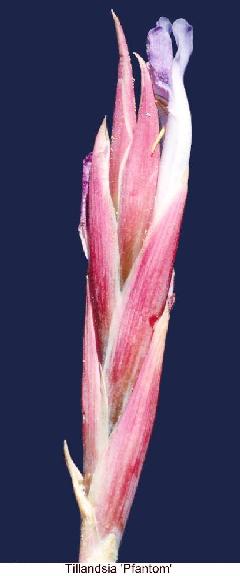
See also similar paper by Eric Gouda, J. Bromeliad Society. Feb 2020. EG 02/20
A new species is generally described from several specimens that share similar attributes and grow in a similar habitat. If a new species is only described from one specimen the chances of it being a natural hybrid increase. Different species can grow side by side in the same habitat because there are barriers to prevent cross pollination. These include different pollinators, different flowering times of the day as well as seasons. Change the ecology of the area by chopping down trees etc and some of the barriers can be broken. Natural hybridising can now occur if species A grows near species B and they flower at the same time. They produce a vigorous hybrid C which is less fecund and the chances are that it will be pollinated by either species A or species B rather than with any other hybrid C. The chance of the hybrid C evolving into a species in its own right are remote unless its vigour wins the day and species A & B die out.
Because everyone’s definition of what is a species and the fact that evolution never stops you have plants described as species but are really hybrids like T. pfeufferi or T. xfloridana.
Let us look at these :
T. pfeufferi 01, 02 was found in a batch of plants called T. didisticha received from Bolivia by a Mr. Pfeuffer in Germany. It was described from this one collection. It has never been found in the wild again. As Walter Till says it is very rare and seems to be a hybrid between T. lorentziana and T. vernicosa and yet was found in a batch of so-called T. didisticha! There is local twist to this, because in 1996 I found an unnamed plant from Knize at David Sheumack’s place and felt sure it was T. pfeufferi. When it flowered I sent details to Walter Till who dashed my identification prowess. It now goes under the cultivar name of ‘Pfantom’ 03, 04




T.xfloridana was treated by Lyman Smith as a variety of T. fasciculata but treated by Harry Luther in 1985 as a natural hybrid between T. bartramii 05 and T. fasciculata var. densispica. He also showed how variations occurred where the two species overlapped suggesting backcrossing. Let us digress for a while. Anyone growing self set seed from a species expects to get similar results as per my own definition of a species. Anyone growing self set seed from a hybrid expects different progeny. Certainly the experience in Australia is that seed from the particular T. xfloridana we have in Australia produces like progeny. The growers in Florida tell me the same thing. My view is that the centre core of T. xfloridana 06, 07 should be treated as species and only those on the perimeter treated as hybrids by formula. This is the normal situation in evolution.
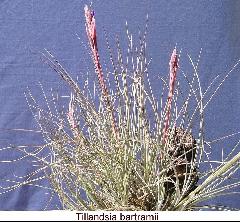
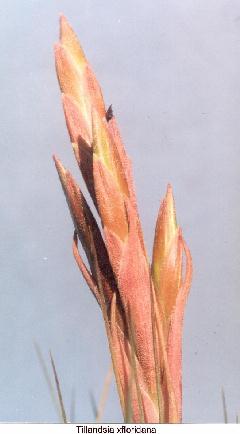
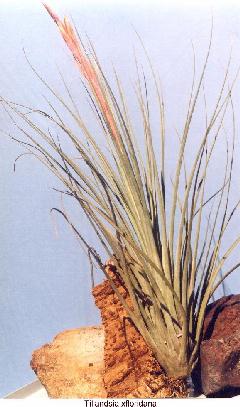
You may have noticed that I have put the parentage in alphabetical order because in the wild you do not know who was ‘mother’, having not been present at conception!
There have been lists of Bromeliaceae species and Bromeliaceae hybrids for some years now but little was mentioned of natural hybrids which are a vital part of evolution. In 2000 when I was striving to get the online Cultivar register operational I realised that natural hybrids were falling into a hole. Whatever information could be gleaned from Smith & Downs and similar publications was a start. Very few natural hybrids were described according to the ICBN rules and mostly were just known by formula which under the ICBN rules are quite acceptable. It is only under Cultivar Rules where this is frowned upon because Anglicised names are preferred to clearly show the difference between plants found in the wild and those created in cultivation. The separation of wild from cultivated plants has been strongly advocated since the middle of the 1800’s by eminent taxonomists but alas there are still problems because the system is voluntary.
What I have found is that more Tillandsia natural hybrids are reported, in increasing numbers, than any other genus. The answer is, I believe, in the depth of interest there is in this genus from a purist point of view rather than man-made hybrids. It may also be because the ‘dry’ forests are being ripped out to form smaller pockets of ‘wild’ vegetation and are more likely to have an effect on weather patterns and pollinators.
When capturing data I like to see a photo of the plant concerned and as much detail I can get as to its locality and why it is thought to be a hybrid. I do not know if you realise that herbarium specimens of natural hybrids are held in many Herbaria around the world but there is no system to record them so nobody knows they are there. I have appealed to some of them but it seems that they prefer them to be unknown. I ask the question that if nobody knows they are there why hold such records! Using my list I was able to advise Ivon Ramirez that Rauh had found T. balbisiana x brachycaulos well before her and perhaps it should be noted in the records of Tillandsia xmaya. I did not have the neck to point out that we already had a Tillandsia ‘Maya’! Natural hybrids are rarer than species and can so easily die out but you never know!
Let us have a quick look at the list which would be much bigger if collectors were aware of its existence and wanted to participate. It is almost the same as the number of Cultivar names registered and not registered.
Let us start with T. argentina x(?)muhriae or is it tenuifolia from Tanti in Argentina 08, 09, 10. This is the plant Len Colgan and I got in the early 1990’s from Renate Ehlers. In 2000 Lydia Kohres could only find 10 in the same spot. Backcrossing with argentina has clearly occurred!
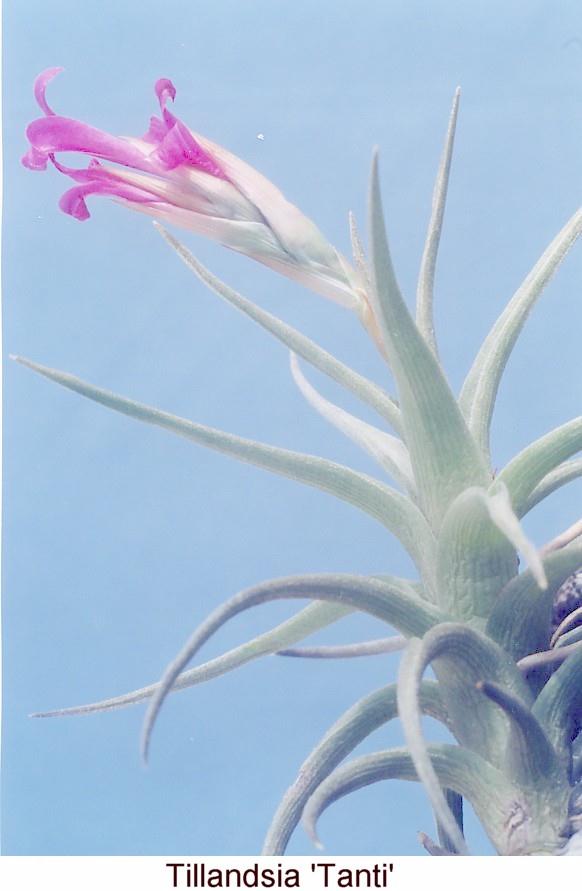
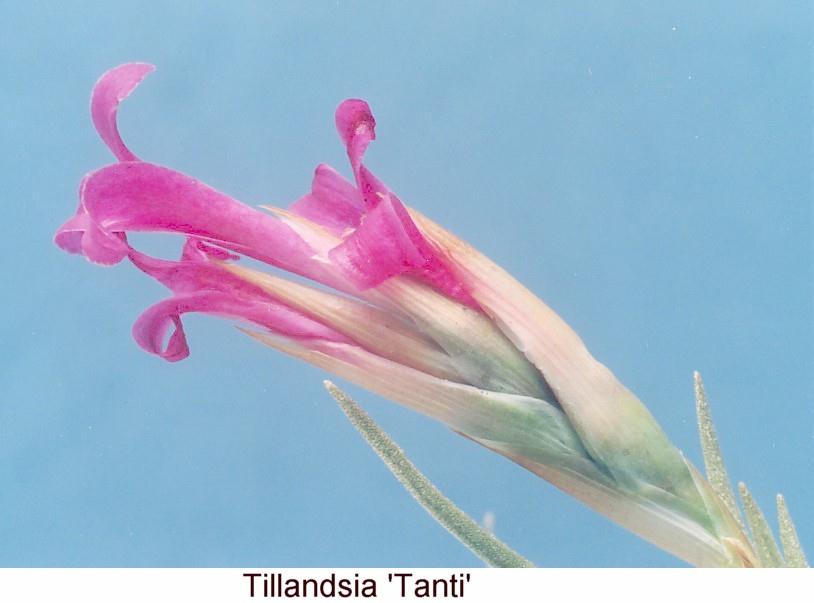
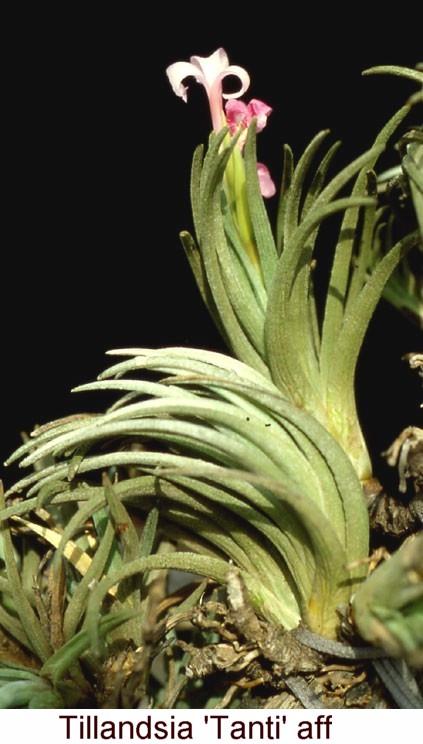
Now to ‘Maya’ already referred to as T. balbisiana x brachycaulos where we will have to make do with a drawing (11), and to the cultivar which has links with T. capitata 12.
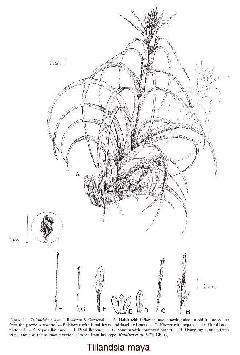
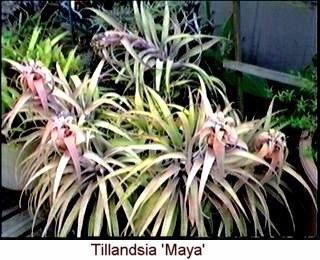
T. xsmalliana is another Florida natural hybrid that worries me a bit but it could all be explained by Harry Luther’s interpretation of what is a natural hybrid. It started off its career in the 1930’s as T. polystachia sensu Small but there seemed to be much doubt by several taxonomists as to this being correct, but nobody took any action. In 1985 Harry Luther took the plunge and considered it to be a natural hybrid between T. balbisiana and T. fasciculata var. densispica. There does seem to be some backcrossing with T. balbisiana as this photo 13 shows. BUT I believe that the predominant form of T. xsmalliana acts like a species. The following photos are of a plant raised from seed by Margaret Paterson 14, 15 from T. xsmalliana, which if it were a hybrid should show differences. BUT it doesn’t !
Just to show the problems of identification, many of you would not have noticed that when Harry wrote about the differences between T. xsmalliana in the Journal of The Bromeliad Society in 1989, there was a bit of a problem. Somehow the drawing of Foster’s 1140, a die hard T. polystachia, was used as an example of T. xsmalliana!!
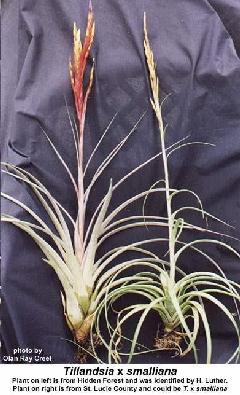

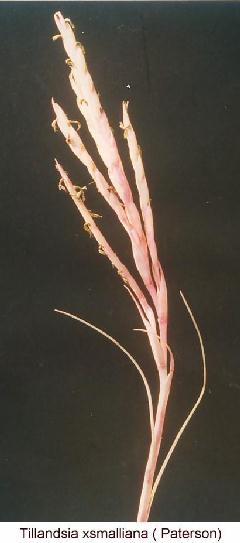
How many of you think that T. brachycaulos var. multiflora means a T. brachycaulos with lots of flowers? I am sure many people do because I have often obtained a plant with this name only to be greatly disappointed when it flowered. You see I am looking for spikes with more than the usual 1 or 2 flowers. T. brachycaulos var multiflora was treated by Lyman Smith as a proper variety and next to it is recorded a T. brachycaulos x caput-medusae with no comment as to their similarity. In 1994 in Flora Mesoamericana, Utley referred to T. brachycaulos v. multiflora as being apparently a hybrid between T. brachycaulos and T. caput-medusae but did nothing about giving it a hybrid name. This left a vacuum with the name T. brachycaulos v. multiflora still being used in the trade.
I believe that this hybrid is rare in Australia even though it has been on BirdRock lists for many years. Who grows this plant? How many flowers does it have? It should look like this. 16.
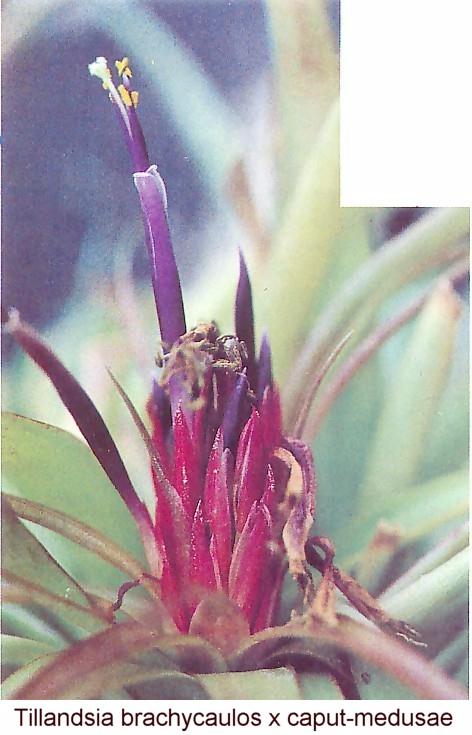
Now to a T. xfloridana look-alike – well I think so. I call it ‘Pachuca’ from the place in Hidalgo, Mexico where Renate Ehlers found the plant. 17, 18. Certainly there seems to be the influence of T. fasciculata but what about the other parent? If it was T. bartramii then we have a problem, - Well at least I do! Lyman Smith treated T. simulata as a synonym of T. bartramii and both grow in Florida. Harry Luther resurrected T. simulata to species status. So if plants come from Florida we should have a rough idea of the plants look like. However, Espejo in Mexico still follows T. bartramii sensu Smith, so although he and Smith report findings of T. bartramii in Mexico is it T. bartramii in the strict sense or T. simulata in the strict sense? Therefore neither Renate nor I are prepared to guess the other parent!
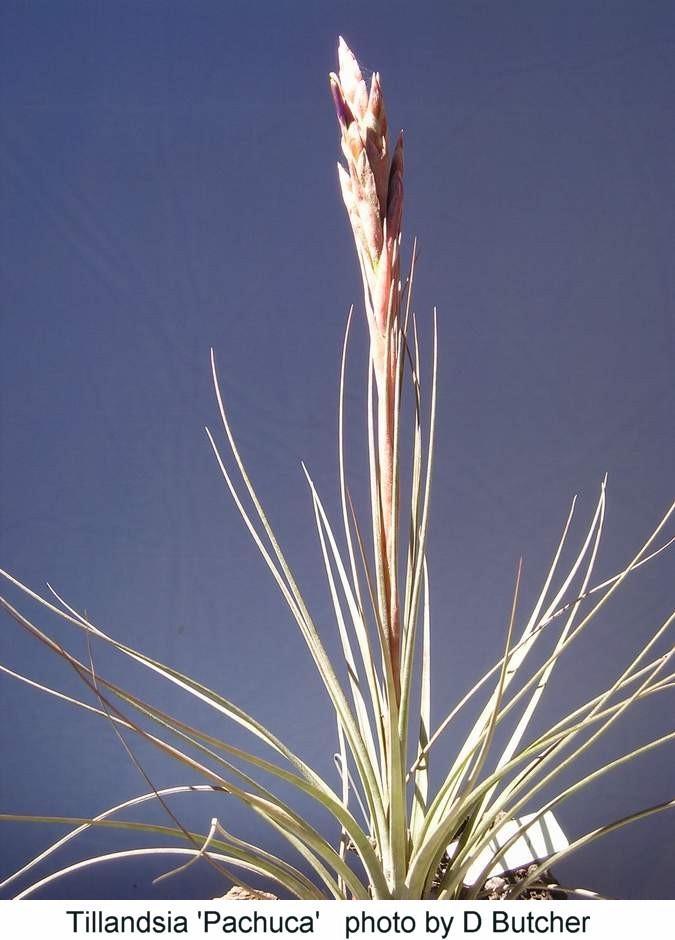
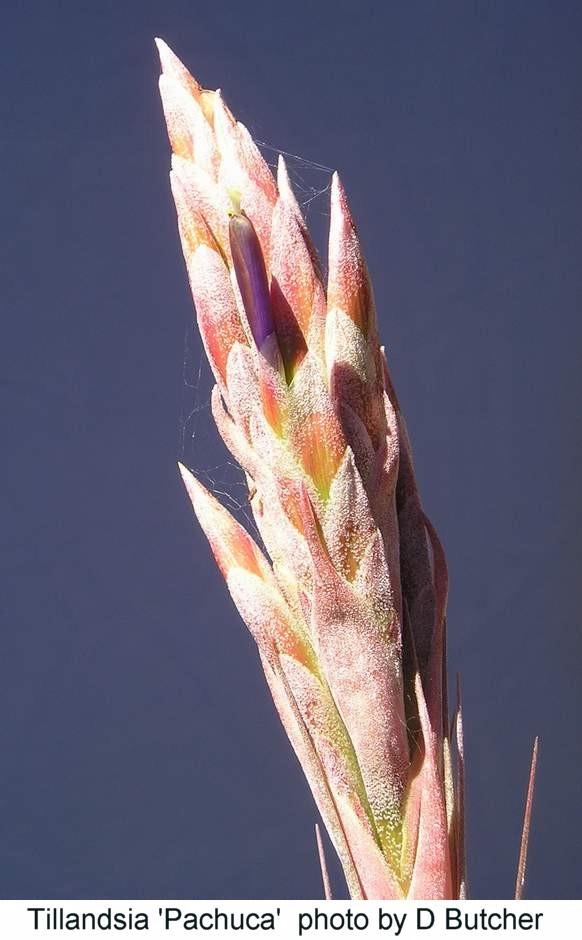
Another problem I encountered was a T. xlineatispica which I got from Renate in 2002. It has not yet flowered! In 1996 in Flora of St. John, US Virgin Islands, mention was made about this natural hybrid (fasciculata x utriculata) but because the plant was still called T. lineatispica Harry still treats it as a species even though he acknowledges its hybridity. Why did Renate let me have the plant?
In 2001 I was busy translating Die Bromelie 3/2000 and doubted my translating when I read that T. lineatispica had been found in the middle of Mexico and yet S&D said that it had only been found on the Virgin Islands. Was this a case of a natural hybrid with the same putative parents? Emails flew back and forth. To my mind the Mexican plant should be described as T. xspinnleriana or just ‘Spinnler’ but the Germans are still arguing 19, 20.
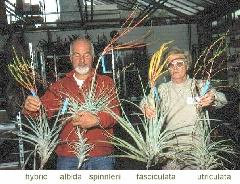
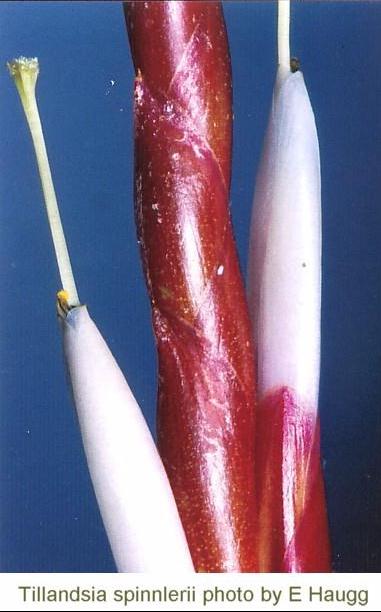
Just another slant on names. T. xrectifolia. This was first named as a man-made hybrid by R. Frasier in Florida in 1979 as ‘Jack Staub’ 21 by crossing schiedeana with ionantha. At about the same time Wiley from California was describing a plant called T. rectifolia. 22. In 1989 Harry Luther treated this taxon as a natural hybrid. So you may come across this plant under the formula or ‘Jack Staub’ or T. xrectifolia. If you have the plant under formula I would suggest that the number of plants that did come out of Mexico will swamp the few that Frasier got and should be called T. xrectifolia!

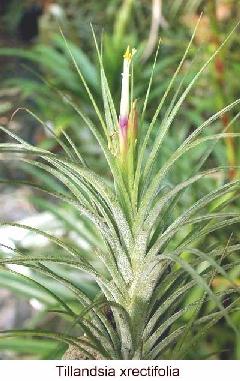
Tillandsia kolbii. I think it has been finally decided that this is not the same as T. scaposa which everybody has. As far as I am aware T. kolbii is not in Australia but that should not stop us from discussing it. First I’ll show you a drawing 23 and then a photo of the holotype 24 that had been collected in 1979. Described in 1981 it did not take Renate Ehlers long to seek out this location because only one collection had been reported. Were there other plants in the area? Despite searches the plant was very elusive although T. matudae was in the area. Other later more extensive searches for this elusive plant failed to find one with purple-violet petals but several with white petals. The original collection was grown on at the Linz Botanical Garden where the Head Gardener reported flowers vaying from white to pale violet white to violet, suggesting hybridity but what parentage! The white version! 25.

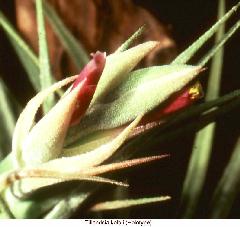

Tillandsia polita has had a chequered career, 26. It was described by Lyman Smith in 1941 but Gardner in the 1980’s found that it appeared to be a hybrid between T. rotundata and T. rodrigueziana and that much back crossing seemed to be happening. In the 1970’s Rolly Reilly and his son-in-law Greg Stewart were busy sowing Tillandsia seed and most of us at that time accepted that Tillandsias did not hybridise easily and did not question too much the name that came with the seedling. I was aware that T. polita was considered to be a natural hybrid so why were all the plants that I had seen from the Reilly/Stewart stable looking alike admittedly with a bit of T. rodigueziana flavour. 27, 28. Needless to say, Harry was advised of my findings in line with the T. xfloridana and T. xsmalliana already mentioned. So it was a bit of a surprise when in 2000 T. polita appeared on the species list. In 2003 Renate Ehlers named a variety as T. polita var. elongata.

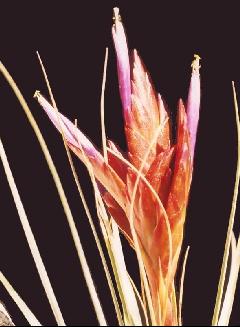
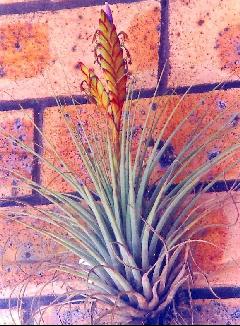
I hope that what I have shown is that defining a species may be hard but defining a natural hybrid is even harder. This is the reason why I believe any suspected natural hybrid should be recorded and not dismissed out of hand! They are after all, rarer than species!
| Parents | Name | Remarks |
| achyrostachys x bourgaei | xmarceloi | BSIJ #5 1999 p213, 214 ill |
| achyrostachys x ionantha | - | Bird Rock TX009 1996 Mex |
| acostae x tricolor var melanocrater | - | Selbyana 16(2):230-234. 1995 Costa Rica |
| aguascalientes x erubescens | - | Bird Rock TX034 1996 Mex |
| argentina x ?muhriae | ‘Tanti’ | Collected from Tanti, Cordoba, Argentina, by Lydia Kohres in 1987 T. argentina and a white plant with small white flower like a small T. xiphioides (?muhriae) Could not be found in subsequent visit in 2000. |
| ariza-juliae x pruinosa | - | Bird Rock TX012 1996 Dominican Rep. New Till Hndbk p108 ill |
| atenangoensis x circinnatoides | - | Mex. El Boqueron, EM052004 |
| baileyi x ionantha | - | Bird Rock TX027 1996 Mex New Till Hndbk p100 ill |
| balbisiana x brachycaulos | xmaya | Ramirez & Carnevali, Novon 13: 209-211. 2003 |
| balbisiana x brachycaulos | - | Rauh 52374 (HEID) |
| balbisiana x fasciculata | - | New Till Hndbk p101 ill |
| balbisiana x fasciculata | - | see ‘Dura Flor’ in BCR Panama |
| balbisiana x fasciculata v. densispica | xsmalliana | Phytologia 57(3) 1985 photo fcbs.org |
| bartramii x fasciculata v. densispica | xfloridana | Phytologia 57(3) 1985 photo fcbs.org and New Till Hndbk p105 |
| bartramii x schiedeana | Pixie | Advice received in Oct 2003 from H Tarver indicates this is a natural hybrid obtained from Wally Berg who said it was collected in Costa Rica. |
| beutelspacheri x flabellata | xbergiana | Bird Rock TX062 1996 Mex New Till Hndbk p101 ill |
| bourgaei x calothyrsus | - | San Francisco Coatlan, Oaxaca Mex leg Ehlers EM980502 |
| bourgaei x macdougallii | - | Sierra Juarez, Oaxaca Mexico, leg Heidt 1991. photo fcbs.org |
| brachycaulos x capitata | - | Rauh 52368 (HEID) |
| brachycaulos x caput-medusae | brachycaulos v. multiflora | Bird Rock TX002 1996 Costa Rica. New Till Hndbk p101 ill Mexico. Rauh 30431A & 45939 (HEID). Linked by J Utley (DeRebus I 1994) to brachycaulos var. multiflora but as yet unproven. see also Rohweder |
| brachycaulos x dasyliriifolia | xmay-patii | JBS 2000p65 and DeRebusIII |
| brachycaulos x fasciculata | - | Bird Rock TX003 1996 Mex |
| brachycaulos x paucifolia | Ask Harry | Sold at Sarasota FL Show in 1998 as capitata ‘760’ Tamazcal which was incorrect. When it flowered it was identified by Harry Luther in 2003 as representative of the Mexican natural hybrid. Cultivar name by B. Timm. photo fcbs.org |
| brachycaulos x schiedeana | ‘Laurie’ as well as ‘Starburst’ | JBS 29(5):217. 1979 also cultivar name of ‘Starburst‘ by B Timm for plant sold by Tropiflora 1997 (natural?) and ‘Laurie’ for plant in Australia |
| brachycaulos x seleriana | - | Rauh 44165 & 44163 (HEID) |
| brachycaulos x streptophylla | - | New Till handbk p110 ill |
| brachycaulos x streptophylla | xjaguactalensis | JBS 2000p62-7 and DeRebusIII |
| brachycaulos x variabilis | - | Rauh 44164 (HEID) |
| brachyphylla x geminiflora | - | Brazil, Rio de Janeiro, Dois Irmaos, Leg. K & R Ehlers 1981 |
| bulbosa x pruinosa | - | See ‘Chanza’ in BCR Costa Rica |
| butzii x pseudobaileyi | - | Bird Rock TX087 1996 Guate |
| butzii x seleriana | - | Gardner, San Cristobal de las Casas, Chiapas, Mex. see Selbyana 7: 384. 1984 |
| capillaris x retorta | - | WT5187 See fcbs.org for photo and comment under castellanii |
| capitata Peach x fasciculata | - | Bird Rock TX004 1996 Mex New Till Hndbk p104 ill |
| capitata x fasciculata | - | Mex., Guerrero, Rincon, 800m, Leg K&R Ehlers also Guerrero Acahuizotlan, EM8909 |
| capitata x harrisii | - | Bird Rock TX022 1996 Mex |
| capitata x polystachia | - | Janitzio, Chiapas, Mex, Assumed parentage. leg. Ehlers. Refer EM880702 in WU |
| capitata x xerographica | - | Guatemala, One form sold by Tropiflora in 1997 as ‘Maya’ |
| caput-medusae x ? | - | Rauh 45939 (HEID) |
| caput-medusae x circinnatoides | - | Bird Rock TX072, 2001 Mex |
| caput-medusae x durangensis | - | see ‘Panuco’ in BCR Sinaloa Mex |
| caput-medusae x hintoniana | xjalisco-pinicola | Die Brom. 1/1986. Original desc. Then in 1987 found to be natural hybrid by Ehlers |
| caput-medusae x streptophylla | - | Bird Rock TX005 1996 Mex New Till Hndbk p110 ill |
| carlos-hankii x oaxacana? | - | Miahuatlan – Pochutla, Oaxaca, Mexico. Leg M Kretz Feb 2003 |
| carlsoniae x eitzii | Xcuchnichim | Guatemala see JBS 55(1); 23-7. 2005 |
| carlsoniae x fasciculata? | - | Leg Ehlers, Mex, Chiapas, Teopisca |
| carlsoniae x vicentina | - | Bird Rock TX019 !996 Mex |
| carlsoniae x vicentina var. wuelfinghoffii | - | Chiapas, Mex. leg. L. Hromradnik, photo taken Summer 2003 fcbs.org |
| circinnatoides x concolor | - | Tomellin, Mex. Leg. R Ehlers EM0502031 |
| circinnatoides x ionantha | - | Bird Rock TX063 1996 Mex |
| circinnatoides x lydiae | - | Mex. Milpilas, EM991902 |
| complanata x emergens? buseri | Xcomplamergens | Ecuador, Napo, Rio Quijos. Manzanares 5541(1995), SEL079432 |
| complanata x fendleri | - | plant photographed by L Dijkgraaf , 2005, at Aguas Calientes railway station, Peru, probably collected by locals in surrounding area. |
| complanata x ionochroma | xcomplachroma | BSIJ #1 1977 p15 ill |
| compressa x fasciculata | - | Gardner 1117.5 (SEL) |
| concolor x ? | Cuicatlan | In Tropiflora Cat 12/2000 as concolor but appears to be a hybrid from near San Juan Bautists Cuicatlan, Oaxaca, Mex |
| concolor x ionantha | - | Bird Rock TX025 2001 Mex |
| concolor x paucifolia | - | Bird Rock TX011 1996 Mex New Till Hndbk p107 ill .Also collected by Wally Berg in 1990’s |
| concolor x streptophylla | - | Bird Rock TX044 2000 Mexico |
| deppeana x imperialis | - | Bird Rock 2000cat. Mexico |
| didisticha x lorentziana | - | NW Argentina, Leg Larson, AU |
| didisticha x pohliana | - | Bolivia, Chuquisaca, leg. A Osinaga, 2005, see Vasquez |
| ehlersiana x schiedeana | Peltry Jellyfish | no provenance other than Mexico. sold by Bird Rock at WBC 2002 |
| ehlersiana x streptophylla | - | Bird Rock TX054 1996 Mex . Also found by Ehlers at type locality of T. ehlersiana |
| erubescens x mexicana | - | Mex. Oaxaca, near Tlaxiaco, 2000m leg J Lautner, L96-42 & Tlaxiaco-El Vergil, 2100m, Ehlers EM071401 |
| erubescens x parryi | - | Mex, Queretaro, near Xichu leg Ehlers EM941702 |
| fasciculata x ? | ‘Pachuca’ | Collected by R Ehlers near Pachuca , Hidalgo, Mexico. Looks like a Mexican xfloridana |
| fasciculata? x flabellata | - | Mex. Oaxaca, road from Santiago Tuxla to Chiquoasen, Leg J Lautner, 2/1998 |
| fasciculata x hondurensis | xcorrealei | Selbyana 5:310-314. 1981 |
| fasciculata x ionantha | xnidus | Bromelien Studien 41 1983 Photo fcbs.org |
| fasciculata x schiedeana | - | Bird Rock TX017 1996 Mex |
| fasciculata x streptophylla | - | Mex. Oaxaca, Sal Melchior Petaza, 2500m, EM070306, 2007. |
| fasciculata x tomasellii | - | Bird Rock TX014 1996 Mex |
| fasciculata x tricolor var.melanocrater | - | Selbyana 16(2):234. 1995 Costa Rica |
| fasciculata x utriculata | xlineatispica | Was species in S&D but see Flora of St John, US Virgin Islands Acevedo-Rodriguez, p. 1996 |
| flexuosa x funckiana | xwilinskii | Gouda, JBS52(3):125-7.2002 |
| gardneri x stricta | xdonatoi | Bradea 4:316-7,326. 1987 |
| incurva x variabilis | xvan-den-bergii | Ehlers & Hase, Die Brom 3: 75-7. 2004 |
| ionantha x ? | - | Bird Rock TX075 2001ill Taxco Mex |
| ionantha x magnusiana | - | Maria Ecatepec, Oaxaca, Mexico. Leg R Ehlers 1981. Photo fcbs.org |
| ionantha x paucifolia | Aleta/Humbug | leg Gardner also BCR named by Frasier and W Timm |
| ionantha x schiedeana | xrectifolia | Bromelien Studien 31 1979 photo fcbs.org |
| jaliscomonticola x roland-gosselinii | xrothii | Bromelien Studien 16 (1976) Gardner 1982 p153 photo fcbs.org |
| jaliscomonticola x xerographica | - | Gardner 1448 (SEL) |
| juncea x schiedeana | - | Bird Rock TX057 1996 Costa Rica |
| juncea x tricolor | - | Bird Rock TX015 1996 Costa Rica |
| kirchoffiana x punctulata | - | Gardner 881 (SEL) highlands of N Puebla, Mex |
| lorentziana x vernicosa | - | Bolivia, Santa Cruz Leg. D Ric 2005, see Vasquez |
| macdougallii x ? | - | Mex, Jalisco, Mazamitla Leg G Noller 1990, fl. coll. R Ehlers, 1.2005. |
| macdougallii x prodigiosa? | - | Mex. Puebla, Juergen Lautner 92/83 |
| macdougallii x violacea | - | Mex. Valle de Bravo, 2450m, L 96/35, Juergen Lautner |
| magnusiana x velickiana | - | Bird Rock TX024 1996 Guate |
| matudae x ? | xkolbii | Copala, Mexico Die Bromelie 3/1999 p67 |
| malyi x krahnii? | - | Hromradnik, Die Brom. Sonderheft 5: 75. 2005, Peru, Ancash, San Luis, 2600m |
| oaxacana x ? | - | Ocotepec, Oaxaca, Mex. 1800m Leg L Kohres, 2007 with setiformis, macdougallii and nuyooensis |
| paucifolia x xerographica | xwisdomiana | BSIJ 1984 p123 ill |
| peiranoi x streptocarpa | - | Arg. Salta, Quebrada de Cafayete, 1800m, Leg Hromradnik |
| pentasticha x prodigiosa | - | Mex. Guerrero, Chalma – Mexcaltepec, 2530m, Ehlers EM071602 |
| pentasticha x query form1 | - | Leg Ehlers 1998, EM981705, Mex, Guerrero, Chalma ?links with T. ilseana |
| pentasticha x query form2 | - | Leg Ehlers 1998, Mex, Guerrero. Tlapa-Chalma |
| pueblensis x schiedeana ss. glabrior | - | Bird Rock TX059 1996 Mex |
| punctulata x standleyi | - | Bird Rock TX020 1996 Guate |
| rodrigueziana x query | - | Temascaltepec, Mexico. Leg Ehlers 1990 (WU) growing with T. supermexicana, T. fasciculata, T. prodigiosa, and T. mexicana. Photo fcbs.org |
| rodrigueziana x rotundata | xpolita | Flora Neotrop . Selbyana 7:372 1984 photo fcbs.org |
| rodrigueziana x tricolor | - | Ococingo, Chiapas, Mex. EM011104, photo fcbs.org |
| rodrigueziana x vicentina | - | Ahuachapan, El Salvador, Rohweder, Ab. Gebiet, Auslandsk. Univ. Hamburg 61; 78. 1956 |
| schiedeana x query | - | Sierra el Tuito, Jalisco Mex Leg Ehlers EM8177 in 1981 and EM901603 in 1990 |
| schiedeana x seleriana | - | Bochil, Chiapas, Mex. leg R Ehlers photo fcbs.org |
| velickiana x vicentina | - | Alux, and near Media Luna, Guatemala Refer Ehlers EG921208, photo fcbs.org |